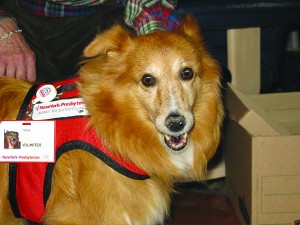Vest-dressed dog is patients’ best friend

Nina, my dog, is a reticent walker. I’ve never understood her contrarian ways. I pull, she stalls. I stop, she pulls. I want to walk to the deli for the morning paper, she drags me to the pet-supply store for yet another treat. But when I put her red New York-Presbyterian vest that reads “Paws for Patients,” Nina knows. This is mission day. She walks the 18 blocks from my house up First Avenue with determination, turns east on 68th Street, crosses York Avenue, enters the cobblestone courtyard of the hospital and aims for the front entrance. She breezes by the guards with a purposeful trot like a doctor making rounds.
We stop at the front desk and check the dog request book. The receptionist asks me to make sure to visit a patient on the 14th floor. Her husband had written, “Dog visit every day.” A few weeks ago a woman in the lobby had spotted Nina and asked how to have the dog visit a relative. We’ll be glad to go, I tell her. “It’s on the 14th floor. It’s my brother.” What’s the matter with him? I ask. “He’s terminal,” she replies and walks away. I hesitate. Should we go? We go.
The 14th floor is the last floor in the building. It is also where some will spend the last days or months in their lives. It is a hushed world on the 14th floor. The woman’s brother is surrounded by family. It’s very quiet in the room. He is resting in an armchair. He doesn’t seem aware of our presence. Someone tells him, “Look who’s here, it’s a dog, Nina.” He doesn’t respond. But then Nina starts licking his hand gently and he pats her on the head. A little moment of hope for his family.
The request for “a dog every day” is also for the 14th floor. The patient welcomes us warmly and with energy. She’s in an armchair. A man is sitting on the edge of the bed. Is it your son or your brother? I ask. “My husband,” she says, acknowledging she probably doesn’t look so great. I apologize for my confusion. I must remember not to talk too much, to let patient and dog get to know each other. It’s not me, it’s Nina the dog they want. At training we were taught not to ask questions, to let the patients decide how much or how little conversation they wish. She’s been at the hospital three months. We’ll be back in a couple of weeks, I tell her. “I’ll still be here,” she says.
There’s a request for the fifth floor. In a room in bed A, a young woman greets us and Nina gets a hug. In bed B, an older woman sleeps, her head falling off the pillow. Her young roommate wakes her up. The woman looks forlorn, a joyless expression in her eyes. Then she sees Nina. The spell of loneliness is broken. She smiles, pets Nina, talks about the dogs in her life. Her late husband’s name was Pierre. Two days later I will pay her another visit. She gives Nina a treat.
At the door of many rooms a sign warns: “Safety alert. Fall prevention. High risk.” A petite senior patient is complaining with vigor at the nurses’ station. After a little harangue she retreats to her room and sits with her back to the door. I decide to visit, not sure of her disposition. Her expression, her voice soften upon seeing Nina. She tells me she is related to Gershwin and hums a tune. Now Irving Berlin, “White Christmas.” She gives me a recipe for ravioli. Very simple. With cheese and spinach. She has a riddle for me: “Which U.S. president had the biggest hat?” Lincoln, Johnson? “No, no,” she says. I give up. “The one with the biggest head,” she announces, very pleased at my failure. She’d love to see Nina come back.
From floor to floor, from one nurses’ station to another. Nina has offered her services. Not everyone wanted a dog. Sometimes it was not the patient but a relative or a friend spending hours near a loved one who needed a dog’s visit and a break from the long hours of caregiving. Sometimes it was Nina who was distracted, torn between the good work she was doing and the lure of cookies I gave patients to give her.
Nurses rush out from behind their counters and lean over Nina with childlike delight. We’ve been here nearly two hours. We go to the volunteers’ office to sign out. Back on the street, a few more smiles, a few “Can I pet your dog?” and “Is she a Lassie?” We cross York, down First Avenue, left on 51st Street. We’re home. I am proud, exhausted. How do they do it, the nurses, day after day, and the night shifts, too? Next week Nina and I will travel to Westchester for a visit to the Lawrence Hospital Center in Bronxville. Terry Martino, the director of volunteer services, will be our guide.
Pierre Gazarian is a poet and a writer of one-act plays. E-mail: [email protected].





